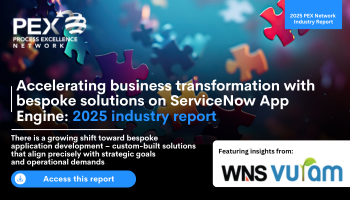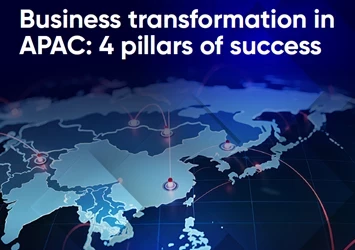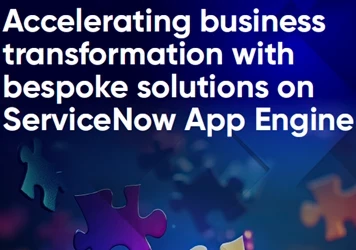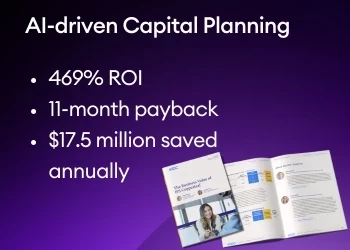Top 27 operational excellence quotes for 2023
PEX Network advisory board members and industry experts share their tips for operational excellence, successful change management and automation initiatives for the year ahead
Add bookmark
PEX Network has compiled a list of the best quotes from experts on the topics that will matter most in 2023. Read on to find out what industry leaders are talking about in terms of operational excellence (OPEX) and how to successfully undergo process automation and change management initiatives.
In this article our experts discuss:
• The main drivers of business transformation: People
• Why operational excellence is vital for all industries
• Business process management should not be a side project
• The benefits of operational excellence in financial services
• Understanding the challenges of operational excellence
• Successfully automating processes
• Keeping customer experience at the forefront of automation strategies
• How to successfully manage change
Join the PEX Network community

Don't miss any news, updates or insider tips from PEX Network by getting them delivered to your inbox. Sign up to our newsletter and join our community of experts.
Learn MoreThe main drivers behind business transformation: People
People-centricity coupled with a strong technology program to help retain top talent are key for business transformation, according to Mark Ghibril, global vice-president and head of regional CIOs and user engagement experience center at Siemens Gamesa.
Ghibril says: “The speed at which organizations are digitally transforming cannot go back, it has to be the same if not quicker – technology is the accelerator and [provides an] advantage to succeed in this new normal.”

Joe Craughan, X disruptor at Novartis, believes that growth driven by operational excellence is a customer-oriented mindset.
“There is a big shift and companies are realizing that you have to be more than the product you offer,” he says. “It has to do with how you impact customers and how to make processes more customer-centric, as well as more effective and efficient for the organization.”
Why operational excellence is vital for all industries
The importance of operational excellence is not limited to the private sector. Keith McDowell is RPA manager at Norfolk County Council in the UK. At a time when local government budgets are facing the pinch, lean and efficient processes are more important than ever.
“We are now in the 21st century, so having poor data quality, inefficient systems, time-consuming processes [in state and local government] must be eradicated,” he says.
Read more: How government agencies can drive OPEX in the public sector
Nedzad Piric, director of digital transformation and smart cities at EU Tech Chamber, echoes this statement when he says: “If organizations do not include OPEX in their digital transformation initiatives, they will fail.”
“For private and public sector OPEX, the main purpose is to create an ecosystem where every employee is empowered to deliver and improve the flow of value to a customer."
“The concepts of OPEX and continuous improvement transcend industries,” says Maureen Terralheiro, vice president, back-office operations at A. Farber & Partners Inc. “It is about ensuring that employees see the flow of value-added steps to the customer and are empowered to solve problems in that flow.”
Business process management should not be a side project
“Operational efficiency is becoming increasingly important for organizations. As a result, the value of business process management (BPM) is being better realized,” says Orhan Toprak, business process manager at oil and natural gas company SOCAR Türkiye.
By deploying a BPM methodology, SOCAR Turkey has transformed from a people-driven organization into a process-driven one, which has improved the way the company approaches problem-solving.
Toprak adds, “Major companies need BPM because their operations are getting more complex and lagging companies need it because their operations are not managed efficiently.”
Read more: Why BPM should not just be a side project
Philippa Sides, head of lean process at Saint Gobain, comments on the benefits of process mining, a cross between BPM and data mining.
She says: “I think the most critical development in recent years has been the move from using process mining primarily for process discovery, as it is now also employed for process conformance initiatives.”
“The ability to check conformance to a process and investigate the reasons for non-compliance, identifying why and how this process has deviated, enables real process transformation.”
The benefits of operational excellence in financial services
In the highly regulated world of financial services, OPEX can help solve customers’ problems (such as by reducing waiting times through automating processes), as well as make internal operations more efficient.
As Vinod Srinivasa, OPEX professional at Bank of America, says: “OPEX is the thread that unifies an organization’s functions and channels them to enhance efficiency in every aspect. OPEX professionals along with leadership should ingrain the excellence culture and mind-set to deliver nothing but excellence to all stakeholders.”
Read more: Achieving OPEX in the financial services sector
Nao Anthony, senior manager of operational excellence at Commonwealth Bank, adds that, “Lean helps solve problems and offer error-proofed solutions from a conceptual perspective such as reducing handovers and stopping unwanted travel times, ultimately accelerating the value flow to customers.”
Understanding the challenges of operational excellence
To reap the benefits of OPEX it’s vital to understand the potential challenges of your sector and make informed decisions before embarking on the process. “The greatest challenge of an industry going digital too early is not the capability of the tools, but the adoption of the market,” explains Katherine Campbell, chief digital officer at Assurance Financial.
“If the market is not ready to apply online, login to their bank accounts on a digital mortgage app, or not willing to upload documents from an app on their phone, then all that ease is not increasing the pace of business,” Campbell adds.
Read more: Why market adoption is critical to the success of mortgage process digitization
Anna John, senior PEX professional and transformation architect at UAE Exchange, says it is important to understand the complex nature of business processes, to be able to assess the efficacy of implementing things like automation. “There are many unseen handshakes like touchpoints, data, tools, systems and documents that work closely together and create event logs when a process is carried out,” John notes. “These handshakes may become unidentified in the end-to-end process.”
The manufacturing sector has its own specific challenges as Marc Winkelman, global director for IWS manufacturing excellence at Procter & Gamble, explains: “The challenges for manufacturing companies are how to be faster, better, cheaper, compliant and sustainable. We need to deliver supply chain results that beat the competition.”

Meanwhile Debashis Sarkar, managing partner of Proliferator Advisory and Consulting, comments on external challenges like high inflation rates, and how these can be turned into opportunity. “[Inflation] is forcing businesses to be more efficient, resulting in them analyzing processes for cost-reduction purposes.”
Data is everything of course, as Tanu Mukherjee, senior director for global process excellence at PepsiCo says: “No one can afford to be data- or technology-illiterate any longer. Gone are the days of whiteboarding process maps. All of us have to understand our processes in real time with data that flows through the applications we use and learn to leverage process mining insights in our day-to-day operations.”
Successfully automating processes
The release of ChatGPT shows the tremendous potential of artificial intelligence and how work done by tech tools is becoming indistinguishable from the work of humans. “We are beginning to see the future of workflow automation in what is happening currently,” says Linford Dailey, global digitalization and automation leader at Bosch. “We can see that automation is most likely going to be moving from mimicking human actions to mimicking the thinking of the human brain.”
Gyte Gedvilaite-Hansen, deputy head of intelligent automation center of excellence at Danske Bank, offers this advice to companies planning to implement automation: “I would advise organizations to focus on the benefit they hope to achieve from the very beginning. This is important to ensure that you prioritize initiatives that bring real and measurable value.”
Dr Anand Kulkarni, director of operations process automation at Elsevier, suggests that forming cross-organizational partnerships is key. “If you want to build a successful automation program and more importantly a sustainable one you need to build partnerships across functions – bring them all together, share the overall vision and purpose of the initiative and align them with the individual functions’ priorities.”
Read more: Accelerating business transformation by leveraging digital process automation
Working closely with the IT department is of course, essential. “We try to have a discussion with IT on which tools could be used to solve a challenge,” explains Gregory Dupuy, head of process and automation business services platform EMEA at Chanel. “Whether it is with robots, a low-code platform or a mix between standard IT and low-code – this can help us save some time in the conception of a solution.”
For Jon Atienza, manager of IA at Coca-Cola, understanding customers is crucial. “Understanding each customer’s profile and journey will help you know what kind of automation can be done on specific profiles.”
Read more: Why low-code is the key to driving agility
Vineet Mehra, general manager, product head and functional process owner – order-to-cash at AP Moller Maersk, has four key pillars for adopting automation. “The four goals [of an automation initiative] should be: to have a clear process design; reduce handoffs between teams; align finance’s vision with the core business priority to ensure a seamless flow of information up and downstream; and engage chief financial officers to sponsor initiatives that have a direct impact on core processes.”
Hyperautomation continues to be a top technology strategy for businesses. Lyudmila Todorovska, Heineken’s global hyperautomation product manager, explains: “The main added value of hyperautomation is that is allows businesses to simplify and automate business processes. By doing so it enables efficiency gains, revenue growth, risk avoidance and improved user experience.”

Going for quick wins is best when it comes to implementation, suggests Yulia Neroslavski, RPA domain lead at Payoneer. “My advice for implementing [intelligent automation] solutions will be to try and to stick with the ‘low-hanging fruit approach.”
“This means choosing the better scope or most valuable player for this project that will bring maximum value in the shortest period of time, enabling you to spend minimum effort on the implementation. It is a very positive and progressive approach which can help to avoid some of the obstacles that companies typically face when starting to implement IA.”
Keep customer experience at the forefront of automation strategies
“The user experience approach is huge and if you have paper-based processes, do not immediately start thinking about AI,” advises Keith Dugas, director of maintenance AI and connected operations at Air Canada.
Dugas, adds that “You need a digitalization strategy if you have not started yet to understand what will become digital and how.”
“If you are already digital you need to consider what data you want the AI tool to ingest and from there, you can better assess what type of artificial intelligence you will need. To achieve this you have to work backward from what the solution will do to understand what kind of tool you need, to understand what your next step needs to be. None of which is straight forward.”

Just as important is fostering a culture of “curiosity”, as Dimitris Papanikolopoulos, service technology leader at 3M explains. “When companies see low-code and no-code, they want to automate everything. Instead, the focus should always be on the culture.”
“The top advice I would give is to create a culture around low-code and no-code as a priority, making people interested and providing them with the tools to go further with the technology. There also needs to be efforts to create an environment that keeps people interested, makes them curious and shares the message that low-code and no-code is the future.”
How to successfully manage change
For any transformation journey to be successful, change management is key. Chris Hetrick, director of the change management center of excellence at Gap Inc says: “Bringing transformative change on top of [the change-saturated] context has brought the need to focus and make the best use of the little change capacity we can get from our employees."
Romina Guevara, chief digital officer for Central America at Michelin, also emphasizes the importance of getting employees on board. “A successful digital transformation process depends on employee buy-in,” she says. “If employees have trouble understanding new technology or if they do not have the right skills to adopt it, the most important pillar supporting this transformation falls away.”
Meanwhile, Dennis Olsson, Danske Bank’s group sustainability change lead, says: “Change management is not about filling in change tools and templates. It is about having experience which makes you able to understand and connect with the end users who are impacted by your change initiative.”
If you liked this article, please share it with your professional network on LinkedIn or with the wider world on Twitter.
Accelerating business transformation with bespoke solutions on ServiceNow App Engine

Today, off-the-shelf software solutions offer diverse features that enable vast opportunities to implement and maintain business transformation. However, in some circumstances, capabilities lack the flexibility and specificity required to address the unique challenges and workflows of individual organizations. As a result, there is a growing shift toward bespoke application development – custom-built solutions that align precisely with strategic goals and operational demands.
Download this report to explore how enterprises can harness the power of custom applications to drive meaningful transformation. With the growing adoption of low-code platforms like ServiceNow App Engine, organizations are building custom applications faster and with greater control. By empowering both IT professionals and citizen developers to build tailored solutions, organizations can significantly reduce time to value while maintaining control over quality and compliance.
Download Now
























